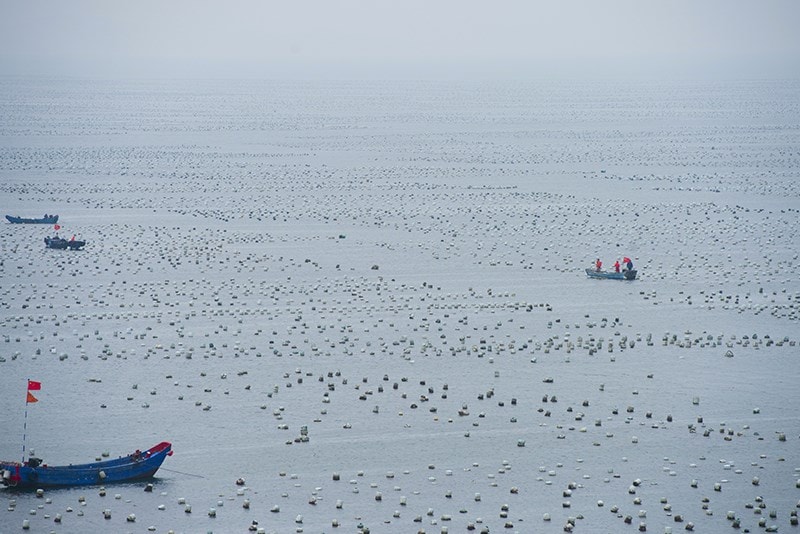China - Fish Farm Incidents
China is one of the world’s largest consumers and producers of fish and over the last 25 years the number of fish farms has increased exponentially. As a result of the increased number and density in Chinese waters, fish farms pose an increasing risk and the danger to vessels navigating these waters is reflected in an increased number of incidents being reported to the Club.

Fish farm arrangement
These farms are set up so that their nets are in ‘culture lines’ which go against the current. They are designed to cultivate mussels, oysters or fish. The farms are widespread, with each farm divided into a number of smaller areas and each area covering more than 1000m in length and 500m in width. A typical image is presented to the left: the items that float on top of the water are either buoys or empty bottles to mark where the nets are.
Local fish farm information
China based P&I correspondents handle dozens of fish farm claims every year, with most of the incidents entailing damage to the netting arrangements of the farm. Of particular concern are the areas off the coast of Lanshan and Rizhao, where oyster and mussel cultivation is prolific. In recent years contact damage incidents near Lanshan have been particularly numerous.
These incidents have predominantly affected new fisheries without obvious markings. Additionally, other fish farms that did have markings but were not identified on the Chinese charts have been involved.
Reasons why collisions happen with fish farms
There are two primary reasons for these types of recurring incidents; firstly, vessels may not be able to avoid entering fish farms and, secondly, mariners do not have up to-date information on the location of these farms to integrate into the passage plan.
Possible reasons why vessels might be unable to avoid these farms include:
The bridge team may not be able to see the boundaries of these fish farms due to the marks not being noticeable or lit at night.
Some farms are located in areas with a frequent flow of commercial vessels, such as port approaches, anchorages and navigable channels. This may result in vessels having little or no room to manoeuvre.
There may be heavy traffic or imminent danger located in the channel which the vessel needs to avoid, requiring deviation from the defined navigation channel.
The lack of up to-date information on farm location can be due the following:
Farms may be outside of VTS coverage areas and therefore not recorded, a particular concern for newly established farms.
There is no geographical extent of these fish farms given by the warnings/notices, only a position is noted.
The local MSA has not published any navigation warnings/notices or the information is only available on their website and in Chinese.
The local agent may not have the information of the location of the newly established fish farms prior to the vessel’s arrival.
Actions to avoid collision with fish farms:
Carefully observe the surrounding area, taking into account all available information and paying particular attention to work or service boats, as these may indicate fish farms in the vicinity. It may be worthwhile to post an additional lookout.
Keep close contact with the VTS centre and pilot stations as they will have the most up to-date information on existing fish farms.
Mark fish farms on the chart.
Download the local Notice to Mariners from the MSA as this should have the most up to date information, particularly for newly established fish farms.
Set up equipment appropriately, particularly the radars, which should be set to X-band (high frequency) so as to help detect smaller objects and with a lowered range scale.
Be familiar with the passage plan before watch (for the navigation officer), taking account of any special notes regarding the prevalence of fish farms in the area.
Proceed at a safe speed when entering an area where fish farms are probable and have anchors at the ready.
Keep the vessel within the defined navigation channel until it is established that there is no farm in the area.
Check with local agents for information about the boundaries of existing fish farms and verify the most suitable track for approach and exit from the port or anchorage.
When entering areas where fish farms are expected, Members are advised to seek the latest information on fish farm activity from their local agent when visiting ports.
Members requiring further guidance are advised to contact the Loss Prevention department.
